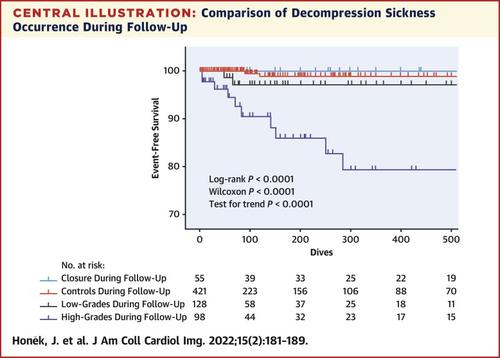JACC: Cardiovascular Imaging ( IF 14.0 ) Pub Date : 2021-08-18 , DOI: 10.1016/j.jcmg.2021.06.019 Jakub Honěk 1 , Martin Šrámek 2 , Tomáš Honěk 3 , Aleš Tomek 4 , Luděk Šefc 5 , Jaroslav Januška 6 , Jiří Fiedler 1 , Martin Horváth 1 , Štěpán Novotný 7 , Marek Brabec 8 , Josef Veselka 1

|
Objectives
This paper sought to evaluate the occurrence of decompression sickness (DCS) after the application of a patent foramen ovale (PFO) screening and risk stratification strategy.
Background
PFO is associated with an increased risk of DCS. Recently, transcatheter closure was reported to reduce DCS occurrence in divers with a high-grade shunt. However, to date, there are no data regarding the effectiveness of any PFO screening and risk stratification strategy for divers.
Methods
A total of 829 consecutive divers (age 35.4 ± 10.0 years, 81.5% men) were screened for PFO by means of transcranial color-coded sonography in the DIVE-PFO (Decompression Illness Prevention in Divers with a Patent Foramen Ovale) registry. Divers with a high-grade PFO were offered either catheter-based PFO closure (the closure group) or advised conservative diving (high grades). Divers with a low-grade shunt were advised conservative diving (low grades), whereas those with no PFO continued unrestricted diving (controls). A telephone follow-up was performed. To study the effect of the screening and risk stratification strategy, DCS occurrence before enrollment and during the follow-up was compared.
Results
Follow-up was available for 748 (90%) divers. Seven hundred and 2 divers continued diving and were included in the analysis (mean follow-up 6.5 ± 3.5 years). The DCS incidence decreased significantly in all groups, except the controls. During follow-up, there were no DCS events in the closure group; DCS incidence was similar to the controls in the low-grade group (HR: 3.965; 95% CI: 0.558-28.18; P = 0.169) but remained higher in the high-grade group (HR: 26.170; 95% CI: 5.797-118.160; P < 0.0001).
Conclusions
The screening and risk stratification strategy using transcranial color-coded sonography was associated with a decrease in DCS occurrence in divers with PFO. Catheter-based PFO closure was associated with a DCS occurrence similar to the controls; the conservative strategy had a similar effect in the low-grade group, but in the high-grade group the DCS incidence remained higher than in all other groups.
中文翻译:

筛查和风险分层策略减少了卵圆孔未闭潜水员减压病的发生
目标
本文旨在评估应用卵圆孔未闭 (PFO) 筛查和风险分层策略后减压病 (DCS) 的发生情况。
背景
PFO 与 DCS 风险增加有关。最近,据报道,经导管闭合可减少具有高级分流的潜水员的 DCS 发生率。然而,迄今为止,还没有关于任何 PFO 筛查和潜水员风险分层策略有效性的数据。
方法
在 DIVE-PFO(卵圆孔未闭潜水员减压病预防)登记中,共有 829 名连续潜水员(年龄 35.4 ± 10.0 岁,81.5% 男性)通过经颅彩色编码超声检查进行了 PFO 筛查。为具有高等级 PFO 的潜水员提供基于导管的 PFO 闭合(闭合组)或建议保守潜水(高等级)。建议有低等级分流的潜水员保守潜水(低等级),而没有 PFO 的潜水员继续不受限制的潜水(控制)。进行了电话随访。为了研究筛查和风险分层策略的效果,比较了入组前和随访期间的 DCS 发生率。
结果
748 名 (90%) 潜水员可进行随访。702 名潜水员继续潜水并被纳入分析(平均随访 6.5 ± 3.5 年)。除对照组外,所有组的 DCS 发病率均显着降低。随访期间,封闭组未发生 DCS 事件;DCS 的发病率与低级别组的对照组相似(HR:3.965;95% CI:0.558-28.18;P = 0.169 ),但高级别组的 DCS 发病率仍然较高(HR:26.170;95% CI:5.797- 118.160;P < 0.0001)。
结论
使用经颅彩色编码超声检查的筛查和风险分层策略与 PFO 潜水员的 DCS 发生率降低相关。基于导管的 PFO 闭合与类似于对照组的 DCS 发生相关;保守策略在低级别组中具有相似的效果,但在高级别组中,DCS 发病率仍然高于所有其他组。



























 京公网安备 11010802027423号
京公网安备 11010802027423号